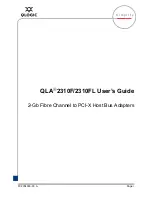
82
Brocade Adapters Troubleshooting Guide
53-1001582-01
Collecting LLDP data (CNAs only)
3
The Basic Port Configuration dialog box displays.
3. Click the Boot-over-SAN tab.
The Boot over SAN dialog box displays.
Collecting LLDP data (CNAs only)
Collect information on the Link Layer Discovery Protocol (LLDP) associated with a specific CNA
using the HCM LLDP Properties panel.
The LLDP Properties panel displays information such as the MAC address of the local system, LLDP
operational status, system management address, user-configured port description, port
identification, configured name of local system, system capabilities based on system model, and
time to live (TTL) values in LLDP frames.
To collect LLDP data, perform the following steps.
1. Select a CNA in the device tree.
2. Click the LLDP tab in the right pane.
Collecting SFP data
This section provides an overview of BCU commands and HCM features that provide information,
on small form factor pluggable (SFP) transceivers.
SFP properties
BCU and HCM provide detailed information on the SFP transceiver for a selected port, such as its
health status, port speed, connector type, minimum and maximum distance, as well as details on
the extended link.
Displaying SFP properties through BCU
Use the diag --sfpshow BCU command to display detailed attributes for a specific SFP transceiver.
diag --sfpshow <port_id>
where:
port_id
ID of the port for which you want to display SFP attributes. This could be the
PWWN, port hardware path, or user-specified port name. This could also be
the adapter-index/port-index. For example, to specify adapter 1, port 1, you
would use 1/1 as the port identification.
















































